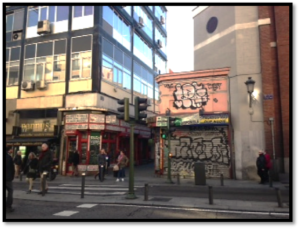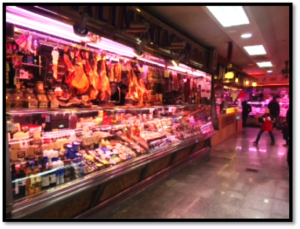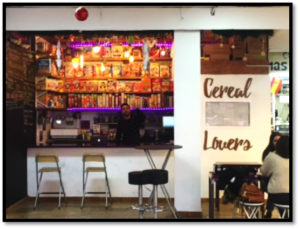by Madeleine Jones, Agricultural and Applied Economics Undergraduate Student at University of Wisconsin-Madison
Our last stop in Spain was Madrid, where I visited the Mercado de Antón Martín. The Mercado de Antón Martín is located in the bohemian district of Huertas, bordering the immigrant barrio of Lavapiés. The Mercado de Antón Martín has been open since 1941, and it is one of the most traditional markets in the city. It is tucked away in an alley, bordered on both sides by artisan cafes, bars, and butcher shops. The market has a bit of an indie vibe, which echoes that of the neighborhood it is in.

The Mercado de Antón Martín is tucked in between Calle de Santa Isabel and Calle de Atocha in the bohemian district of Huertas, bordering the immigrant barrio of Lavapiés.
A few carts line the outside of the building, but most of the market’s 63 stalls are inside of the two-story establishment. They tout an astonishing variety of wares: clothing, meats, produce, herbs, wine, packaged foods, regional specialties (e.g., Iberian ham), and more. Organic food stalls, wine bars, and a craft beer shop emphasize the hipster feel, and there is even a space for cooking demonstrations and small art exhibits.

A few stalls line the outside of the Mercado de Antón Martín, but most of the market’s 63 stalls are inside the two-story establishment.

The Mercado de Antón Martín offers an astonishing variety of goods including regional specialties like Iberian ham, as seen hanging from the top of this stall.
The Mercado de Anton Martín’s success is partly due to the fact that vendors are highly attuned to their customers’ demands. A recent influx of high-income professionals who prefer high-quality organic products has profited the market. New vendors have moved into the market in response to the demands of these shoppers, offering high-quality gourmet items such as Yoko, a vendor offering Japanese carryout food. Some of the vendors have expressed interest in adding more specialized offerings like natural, fresh-squeezed juices. However, current city ordinances governing municipal markets prevent this. I did see a smoothie bar at the market, and it seems vendors are doing their best to capitalize on market trends, even if they cannot take advantage of the “juicing” craze. Overall, there are marked attempts to satisfy the tastes of emerging and increasingly dominant consumer groups like young people and tourists. A further attempt to draw in homesick tourists is exemplified in shops like Best of Britain, which sells products like Heinz baked beans and offers language learning events.

Vendors are highly attuned to the demands of tourists and young consumers, as demonstrated by specialty shops catering to these demographics like “Cereal Lovers.”
Tourists are not the only ones who frequent the Mercado de Antón Martín. Immigrants comprise another important market segment, especially Latin American buyers. In particular, vendors make a special effort to cater to Ecuadorian tastes, and just last year, two new Ecuadorian produce vendors established themselves in the market. Thanks to these establishments, shoppers can buy yuca, plátano macho verde (green bananas), and maíz para tostar (toasting corn).

Fresh produce remains an important category in the market. Regional produce vendors offer goods from abroad (especially South America) to tap into the immigrant market.
Lastly, the Municipal Market of Antón Martín continues to maintain its traditional lifelong client base. This segment consists of women over 65 who almost daily go to the market to buy produce. In many cases, the vendors have known these clients for 20 years or more, and have a jovial and personal relationship with them. As one merchant puts it, “They are old people who, sometimes do not need anything but come to see you.”
Visiting Spain was truly a vibrant cultural experience, and visiting the marketplaces there gave me a much better sense of the traditions, current trends, cultural values, and of course, culinary offerings that make Spain what it is!


Leave a Reply
You must be logged in to post a comment.